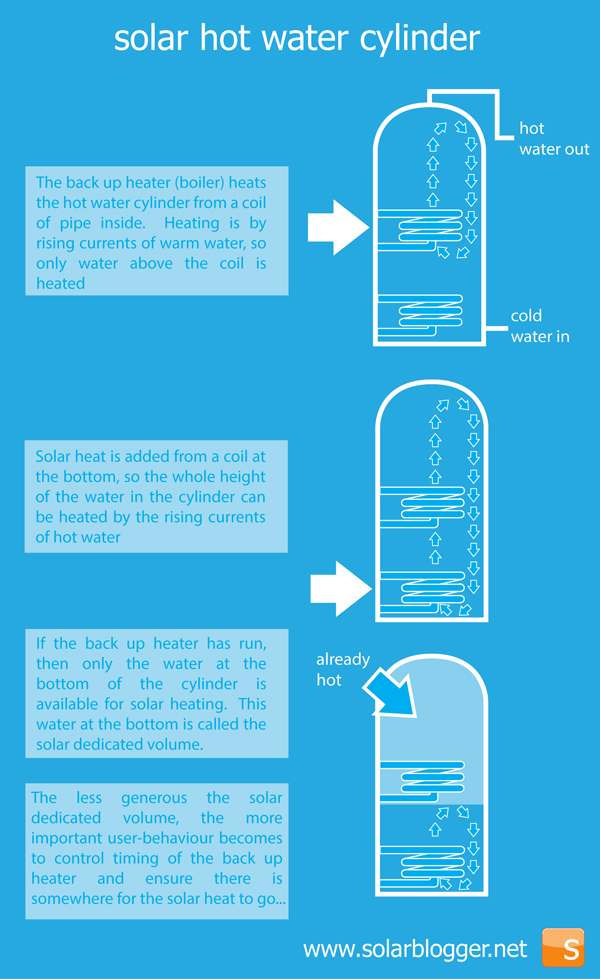Engineers and designers working
with solar heating systems have wonderful simulation software available to
calculate the energy that will be produced by their designs. However, the seductively accurate predictions
they can produce utterly fail to take into account the biggest single influence
on most solar heating systems – the people using them.
You see, people don’t always
behave like engineers expect them to.
A study by Viridian Solar
monitored the performance of solar water heating systems in six homes. The houses were rented, and the two landlords
had paid for the installation.
Householders received instructions on how to get the most out of the
system, and being in the social rented sector had a higher motivation than
average to control their expenditure on fuel.
And yet...
More recently, a larger study of around 100 homes by the Energy Saving Trust was published. The houses were privately owned in this
case. They had spent their own money on
the solar installation, and were “Early Adopters” of the technology so it’s
hard to imagine a more engaged and motivated set of users. And yet...
How to get the Least from Your Solar Heating System
Both studies found that a
significant proportion of the households were not controlling their back up
heater relative to the timing of their hot water use to get the most from their solar
heating. The diagram below explains.
In any solar installation where
the back-up heater (for example a boiler) heats the same volume of water as the
solar panels, the timing of when the back-up heater fires will influence the
solar energy collected.
The most common solar water
heating set up is shown above – a twin coil cylinder.
The back-up heater heats the
water inside the hot water store (or cylinder) by pumping central heating fluid
through a coil of pipe inside the cylinder.
Water surrounding the coil is warmed and heat is transferred around the
cylinder by convection – rising currents of warmer water. Since hot water rises, the coil can only heat
the volume of water above it and a volume of water below is left unheated. This unheated volume that the back-up heater cannot heat is called the “dedicated
solar volume”.
The solar panels heat the
cylinder from a second coil of pipe at the bottom of the cylinder, and so can
heat the whole height of the water in the cylinder.
Most domestic buildings have a fairly
well-defined pattern of hot water use, with periods of highest use in the
evening and/or morning. If the back-up
heater is timed to come on and then switch off before the period of high hot
water use starts, then the hot water is taken out of the top of the
cylinder and replaced with cold water at the bottom. When the sun comes out and the solar panels
start to work, there is the largest possible volume of cold water available in
the cylinder for them to heat up.
If instead the back-up heater
continues to run during and after the period of hot water use, then the whole
top part of the cylinder will be at its maximum temperature. Fossil-fuel fired heaters will heat the water
so quickly that it only needs to over-run the period of water use by 20-30
minutes and the water will be hot again. When the solar panels start to work,
the only cold water is at the bottom of the cylinder – the dedicated solar volume.
Once this water is heated to the maximum safe temperature, there is nowhere else to put the
solar energy, the solar panels must switch off, even if there is plenty more
energy available that day.
This reduces the amount of energy saving from the solar panels by an amount that can dwarf the impact
of other factors such as whether the panels face due south.
The Importance of Dedicated Solar Volume
If even the most motivated of
solar system owners are prone to timing the back-up heater to reduce solar
yield, what hope is there once the forthcoming Renewable Heat Incentive moves solar
heating into the mainstream?
Fortunately, there’s a very simple
answer.
The larger you make the dedicated
solar volume (that bit of the cylinder that the back-up heater cannot heat) the
less sensitive the system becomes. A system with dedicated solar volume approaching
the daily hot water use of the household would be much less affected by poor use of the back-up heater.
Products are available that allow
the conversion of existing cylinders to accept a solar heat input. These have the advantage of being more economic, but the disadvantage is that the dedicated solar volume is
zero, since the boiler heating coil is at the base of the cylinder. Poorly timed use of the back-up heater in
such systems will reduce the available capacity in the cylinder for solar
energy down to nothing effectively wiping out the solar energy savings on that day. Such products have a place, but only where
the user is completely bought into the fact that they must closely control
their heating system.
Some manufacturers have proposed a boiler
interlock to improve matters. If the solar panels are heating the cylinder, the interlock prevents the boiler from firing. The reason this doesn’t
solve the problem is that if the hot water is used in the evening or early
morning, there is ample time for the boiler to re-heat the cylinder before the
solar panels start to work.
The only
sure-fire way to ensure that a solar water heating system really delivers on promised energy savings is to ensure
adequate dedicated solar volume.

